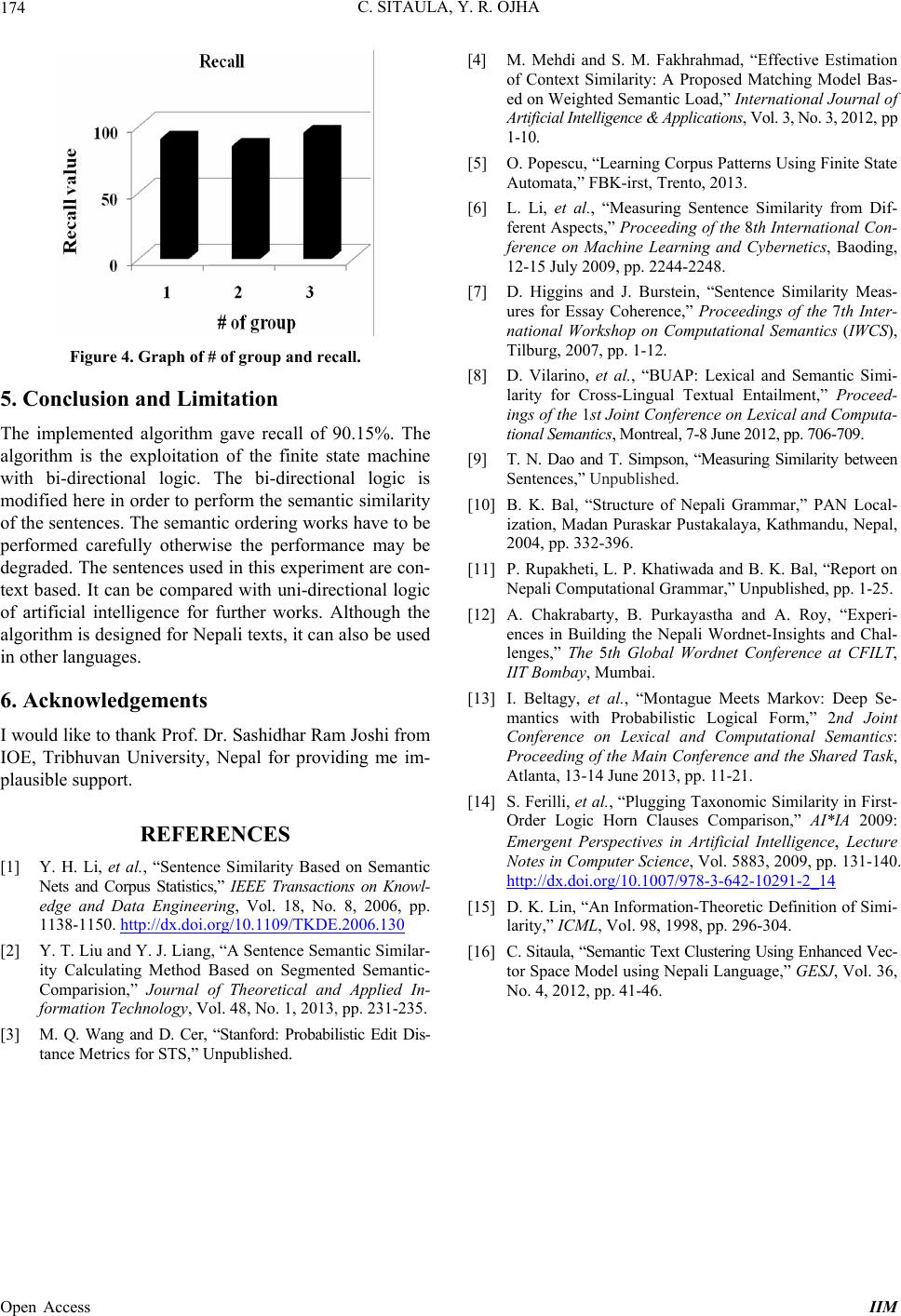
C. SITAULA, Y. R. OJHA
Open Access IIM
174
Figure 4. Graph of # of group and recall.
5. Conclusion and Limitation
The implemented algorithm gave recall of 90.15%. The
algorithm is the exploitation of the finite state machine
with bi-directional logic. The bi-directional logic is
modified here in order to perform the semantic similarity
of the sentences. The semantic ordering works have to be
performed carefully otherwise the performance may be
degraded. The sentences used in this experiment are con-
text based. It can be compared with uni-directional logic
of artificial intelligence for further works. Although the
algorithm is designed for Nepali texts, it can also be used
in other languages.
6. Acknowledgements
I would like to thank Prof. Dr. Sashidhar Ram Joshi from
IOE, Tribhuvan University, Nepal for providing me im-
plausible support.
REFERENCES
[1] Y. H. Li, et al., “Sentence Similarity Based on Semantic
Nets and Corpus Statistics,” IEEE Transactions on Knowl-
edge and Data Engineering, Vol. 18, No. 8, 2006, pp.
1138-1150. http://dx.doi.org/10.1109/TKDE.2006.130
[2] Y. T. Liu an d Y. J. Lian g, “A Sente nce Sema ntic Simi lar-
ity Calculating Method Based on Segmented Semantic-
Comparision,” Journal of Theoretical and Applied In-
formation Technology, Vol. 48, No. 1, 2013, pp. 231-235.
[3] M. Q. Wang and D. Cer, “Stanford: Probabilistic Edit Dis-
tance Metrics for STS,” Unpublished.
[4] M. Mehdi and S. M. Fakhrahmad, “Effective Estimation
of Context Similarity: A Proposed Matching Model Bas-
ed on Weighted Semantic Load,” International Journal of
Artificial Intelligence & Applications, Vol. 3, No. 3 , 2012 , pp
1-10.
[5] O. Popescu, “Learning Corpus Patterns Using Finite State
Automata,” FBK-irst, Trento, 2013.
[6] L. Li, et al., “Measuring Sentence Similarity from Dif-
ferent Aspects,” Proceeding of the 8th International Con-
ference on Machine Learning and Cybernetics, Baoding,
12-15 July 2009, pp. 2244-2248.
[7] D. Higgins and J. Burstein, “Sentence Similarity Meas-
ures for Essay Coherence,” Proceedings of the 7th Inter-
national Workshop on Computational Semantics (IWCS),
Tilburg, 2007, pp. 1-12.
[8] D. Vilarino, et al., “BUAP: Lexical and Semantic Simi-
larity for Cross-Lingual Textual Entailment,” Proceed-
ings of the 1st Joint Conference on Lexical and Computa-
tional Semantics, Montreal, 7-8 June 2012, pp. 706-7 09.
[9] T. N. Dao and T. Simpson, “Measuring Similarity between
Sentences,” Unpublished.
[10] B. K. Bal, “Structure of Nepali Grammar,” PAN Local-
ization, Madan Puraskar Pustakalaya, Kathmandu, Nepal,
2004, pp. 332-396.
[11] P. Rupakheti, L. P. Khatiwada and B. K. Bal, “Report on
Nepali Computational Grammar,” Unpublished, pp. 1-25.
[12] A. Chakrabarty, B. Purkayastha and A. Roy, “Experi-
ences in Building the Nepali Wordnet-Insights and Chal-
lenges,” The 5th Global Wordnet Conference at CFILT,
IIT Bombay, Mumbai.
[13] I. Beltagy, et al., “Montague Meets Markov: Deep Se-
mantics with Probabilistic Logical Form,” 2nd Joint
Conference on Lexical and Computational Semantics:
Proceeding of the Main Conference and the Shared Task,
Atlanta, 13-14 June 2013, pp. 11-21.
[14] S. Ferilli, et al., “Plugging Taxonomic Similarity in First-
Order Logic Horn Clauses Comparison,” AI*IA 2009:
Emergent Perspectives in Artificial Intelligence, Lecture
Notes in Computer Science, Vol. 5883, 2009, pp. 131-140.
http://dx.doi.org/10.1007/978-3-642-10291-2_14
[15] D. K. Lin, “An Information-Theoretic Definition of Simi-
larity,” ICML, Vol. 98, 1998, pp. 296-304.
[16] C. Sitaula, “Se mantic Text Clustering Using Enhan ced Vec-
tor Space Model using Nepali Language,” GESJ, Vol. 36,
No. 4, 2012, pp. 41-46.